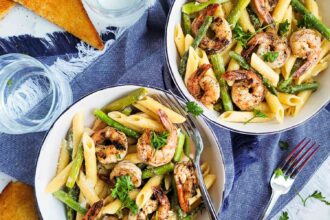Introduction: The Importance of Eating Healthy on a Budget
Eating healthy on a budget can often feel like an uphill battle. Many people believe that nutritious meals come with a hefty price tag, but that’s far from the truth. With a little creativity and smart planning, anyone can enjoy delicious dishes without breaking the bank. The key lies in understanding how to make clever food substitutions. By swapping out unhealthy ingredients for healthier alternatives, you not only improve your diet but also save money.
Imagine replacing costly superfoods with affordable options that pack just as much nutritional punch! Or consider transforming your favorite comfort foods into guilt-free versions that satisfy cravings without impacting your wallet. This journey toward better eating doesn’t have to be overwhelming—it’s about making small, manageable changes that lead to significant improvements over time.
Whether you’re curious if a gluten-free diet is healthier or wondering if going vegan might offer more benefits, you’ll discover solutions right here. Get ready to embrace budget-friendly choices while nourishing your body and mind!
The Benefits of Food Substitutions for a Healthier Diet
Food substitutions offer a gateway to healthier eating without breaking the bank. By swapping out certain ingredients, you can enhance nutritional value while maintaining flavor.
Consider replacing white rice with quinoa or cauliflower rice. Both options boost fiber and nutrients, making meals more satisfying.
Alternatively, Greek yogurt makes an excellent stand-in for sour cream in dressings and dips. It adds creaminess along with added protein, turning indulgent recipes into wholesome ones.
Even simple changes like using whole grain bread instead of white can transform your meals significantly. Whole grains provide essential nutrients that refined products lack.
These creative swaps not only improve your health but also encourage exploration in the kitchen. Trying new foods expands your palate and introduces exciting flavors you may have overlooked before.
Creative Substitutions for Common Unhealthy Foods
Swapping out common unhealthy foods can transform your meals without breaking the bank. Instead of using sour cream, try Greek yogurt. It adds a creamy texture and boosts protein content.
Craving chips? Reach for air-popped popcorn instead. It’s light, crunchy, and can be seasoned to perfection with herbs or spices.
For that sweet craving, ditch sugary cereals in favor of oatmeal topped with fresh fruits and a drizzle of honey. This change offers more fiber and nutrients to kickstart your day.
When making sauces or dressings, substitute mayo with avocado. Not only is it heart-healthy, but it also provides a smooth consistency packed with vitamins.
Chocolate lovers can enjoy cacao nibs as an alternative to chocolate bars. They deliver rich flavor along with antioxidants while being lower in sugar.
These simple swaps make eating healthier exciting and affordable!
Cheap and Nutritious Alternatives to Expensive Superfoods
Superfoods often come with a hefty price tag. But you don’t need to break the bank to eat well.
Quinoa, for example, is celebrated for its protein content but can be costly. Instead, consider swapping it out for lentils or chickpeas. Both are rich in protein and fiber, plus they’re much easier on your wallet.
Another trendy superfood is acai berry powder. Look no further than frozen berries available at your local grocery store. They pack a nutritional punch and cost significantly less.
Kale has gained fame as a health powerhouse, yet collard greens or spinach provide similar benefits without the premium price.
Don’t overlook good old oats either! They offer heart-healthy benefits like chia seeds but are far more affordable.
Eating healthy doesn’t have to strain your budget when you know where to look. Simple swaps can keep both your diet and finances thriving.
How to Meal Plan and Shop Smart to Save Money
Meal planning is a game-changer for anyone looking to save money while eating healthy. Start by reviewing your pantry and fridge. Use what you already have before buying more.
Create a weekly menu that highlights seasonal produce. Seasonal fruits and vegetables are often cheaper and fresher, making them a great choice for your meals.
When shopping, stick to your list. Impulse buys can quickly add up and derail any budget plans. Consider shopping at local farmers’ markets or discount grocery stores for better deals.
Don’t forget about bulk purchases! Items like rice, beans, and grains are usually cheaper when bought in larger quantities. They’re versatile too—perfect for various dishes throughout the week.
Make sure to check sales ads before heading out so you can plan around discounts on items you regularly use. This small effort pays off significantly over time; enjoy savings alongside delicious meals!
Tips for Making the Most of Leftovers and Reducing Food Waste
Leftovers can be a treasure trove if you know how to use them creatively. Start by storing your extras in clear containers. This simple trick makes it easier to see what you have and reduces the chances of forgetting about that delicious stir-fry.
Transform last night’s dinner into something new. For example, leftover roasted vegetables can become a hearty soup or a filling for an omelet. A bit of imagination goes a long way in reinventing meals.
When planning your week, consider making large batches intentionally. Cook extra portions with the idea that they’ll morph into different dishes throughout the week.
Don’t forget about freezing! If you have too much food on hand, freeze individual servings for later enjoyment. Just label each container so you remember what’s inside when hunger strikes again.
Prioritizing Health and Saving Money with Creative Food Substitutions
Prioritizing health while being mindful of your budget is achievable with a little creativity and resourcefulness. By making simple food substitutions, you can enjoy nutritious meals without breaking the bank. For instance, swapping white rice for quinoa or using lentils instead of ground beef not only boosts your diet’s healthiness but also saves you money.
When considering whether a gluten-free or vegan diet is healthier, think about how these choices align with your overall nutritional goals. Both diets offer opportunities to incorporate more whole foods, fruits, and vegetables into your meals. However, it’s essential to ensure you’re getting enough nutrients that might be lacking in restrictive diets.
Planning ahead plays a critical role in managing both health and finances. Create meal plans that focus on seasonal produce and use what you already have at home. Embrace leftovers; they’re an excellent way to minimize waste while ensuring you never go hungry.
Get creative in the kitchen! Experiment with new recipes that utilize affordable ingredients or try out different cuisines that emphasize plant-based options or naturally gluten-free foods. With each small substitution you make, you’re taking steps towards better health without overspending.
Keep exploring these alternatives as part of your journey towards eating well on a budget—your body and wallet will thank you!










